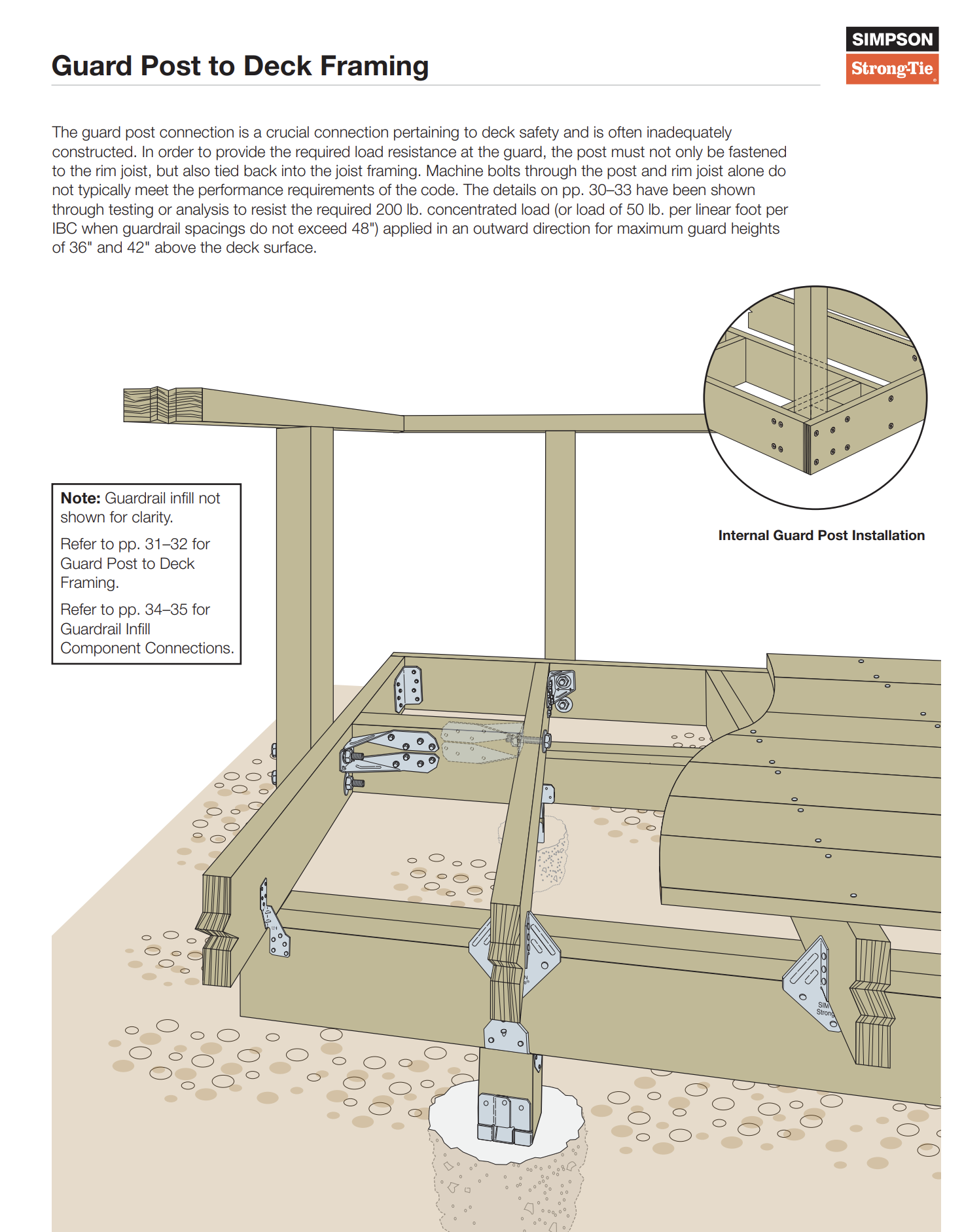A guard post connection is vital for deck safety and often improperly constructed. Ensuring that guard posts are securely fastened to the deck framing is essential to meet building code requirements and provide the necessary load resistance. This blog will discuss the importance of proper guard post connections, building code requirements, and solutions provided by Simpson Strong-Tie.
Importance of Proper Guard Post Connections
Guard posts must be securely attached to the deck framing to resist a 200 lb. concentrated load or a load of 50 lb. per linear foot (as per IBC when guardrail spacings do not exceed 48″). Simply fastening the post to the rim joist with bolts is not sufficient. The post must be tied back into the joist framing to meet performance requirements.
Simpson Strong-Tie Solutions for Guard Post Connections
Guard Post to Deck Framing — Holdown Details
DTT2 Deck Tension Tie
- Application: Suitable for 36″ and 42″ tall guard posts.
- Features: Available with ZMAX® coating or in stainless steel, includes SDS Heavy-Duty Connector screws.
- Usage: Can secure 42″ guard posts with 2×10 (minimum) deck joists.
HTT4 Tension Tie
- Application: Provides strong tension ties for guard posts.
- Features: Available with hot-dip galvanized coating.
ATR All Threaded Rod/RFB Retrofit Bolt
- Application: Ideal for retrofit applications.
- Features: Available with hot-dip galvanized coating or in Type 316 stainless steel.
Alternative Solutions Using Strong-Drive® SDWS Timber Screws
As an alternative to typical hardware and through-bolts, guard posts can be attached using Strong-Drive® SDWS Timber screws. These solutions are code report listed in IAPMO UES ER-192 and verified for 36″- and 42″-tall guard posts constructed with DFL, HF, and SP framing.
- Fasteners: Only SDWS22500DB and SDWS22800DB fasteners should be used. Generic fasteners do not provide adequate withdrawal resistance, pull-through resistance, or shear strength.
Building Code Requirements for Guard Post Connections
When Required
- IRC 2018/2021 Section R312.1.1
- IBC 2018/2021 Section 1015.2
- Guards must be located along open-sided walking surfaces more than 30″ above the floor or grade below.
Height Requirements
- IRC 2018/2021 Section R312.1.2
- IBC 2018/2021 Section 1015.3
- Guards must be a minimum of 36″ tall (IRC) or up to 42″ tall for certain occupancies (IBC).
Load Resistance
- IRC 2018/2021 Table R301.5
- IBC 2018 Section 1607.8.1.1
- IBC 2021 Section 1607.9.1.1
- Guards and handrails must resist a single concentrated load of 200 lb., applied in any direction at any point along the top.
Handrails and Guards Load Requirements
- IBC 2018 Section 1607.8.1
- IBC 2021 Section 1607.9.1
- Must resist a load of 50 lb. per linear foot (not required for one- and two-family dwellings).
Guardrail Infill Components
- IRC 2018/2021 Table R301.5
- IBC 2018 Section 1607.8.1.2
- IBC 2021 Section 1607.9.1.2
- Must withstand a horizontal load of 50 lb. over an area of one square foot.
Opening Limitations
- IRC 2018/2021 Section R312.1.3
- IBC 2018/2021 Section 1015.4
- Guardrail infill must not allow passage of a sphere 4″ in diameter.
Conclusion
Ensuring proper guard post connections to deck framing is crucial for deck safety and compliance with building codes. By using high-quality solutions from Simpson Strong-Tie, such as the DTT2 Deck Tension Tie, HTT4 Tension Tie, and Strong-Drive® SDWS Timber screws, you can achieve secure and compliant guard post installations. Always consult with a qualified professional to verify that your deck’s guard post connections meet all necessary standards.
For immediate service or consultation, you may contact us at Allied Emergency Services, INC.
Contact Information:
- Phone: 1-800-792-0212
- Email: Info@AlliedEmergencyServices.com
- Location: Serving Illinois, Wisconsin, and Indiana with a focus on the greater Chicago area.
If you require immediate assistance or have specific questions, our human support is readily available to help you.
Disclaimer: This article is intended for informational purposes only. For professional advice, consult experts in the field.










